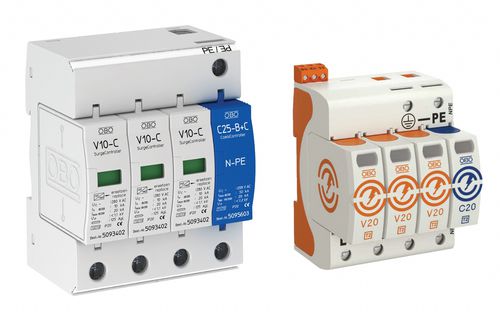
Type 2 surge protector class IItype 1electronic equipment
Add to favorites
Compare this product
Characteristics
- Type
- type 2, class II, type 1
- Applications
- electronic equipment
- Other characteristics
- DIN rail
- Voltage
280 V
- Primary current
Max.: 20,000 A
Min.: 10,000 A
Description
In order for the Surge Protection Devices (Surge Arresters) devices to operate smoothly, there must be a grounding system with a surge arrester correctly selected according to the protection zone and the line to be protected and potential equalization point / points established within the framework of valid standards.
Second Stage: Type 2 / Class 2 / C Class Surge Protection Devices (Surge Arresters) are circuit elements used in the secondary and / or lower secondary panels of the facility / building. Compared to Type 1 / Class II surge arresters, their strength is lower but their sensitivity is better.
Some models have contacts that are active when malfunctioning and / or indicators that indicate malfunction by changing colors.
It should have been tested in an 8/20 µSec waveform. It must be able to discharge a load of at least 10kA between Phase-Neutral, and at least 25kA between Phase, Neutral-Earth.
While Yıldırım poses a clear threat to a building / facility, it is also a growing threat for these systems due to the increasing use of electrical and electronic equipment inside.
In this context, EN / IEC 62305 standard handled the issue of Lightning Protection as a whole and offered solutions to prevent all risks. Accordingly, a correct application project supported by external and internal lightning systems for protection from lightning will provide a cost-effective protection to minimize loss of life, property and time.
Catalogs
No catalogs are available for this product.
See all of Liva Group‘s catalogsRelated Searches
- Surge protector
- DIN rail surge protector
- Type 2 surge protector
- Class I surge arrester
- Class II surge arrester
- Compact surge protector
- Type 3 surge protector
- Class I surge protector
- Electronic equipment surge protector
- Lightning conductor
- Stainless steel lightning conductor
- RJ45 surge protector
- Single-rod lightning rod
- Copper lightning rod
- Spark gap
- Video signal surge protector
- Aluminum lightning conductor
- Insulation spark gap
*Prices are pre-tax. They exclude delivery charges and customs duties and do not include additional charges for installation or activation options. Prices are indicative only and may vary by country, with changes to the cost of raw materials and exchange rates.










